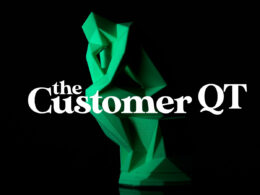Return-on-investment may not be a highlighted portion of The Handbook of Corporate Social Responsibility, but it sure is in an annual report.
Everyone from Helen Keller to King Carl XVI Gustaf of Sweden gets credit for the admonition, “Nobody can do everything, but everyone can do something.” Doing something is good. Witness the world’s reaction to the crisis in the Ukraine.
It’s a noble sentiment no matter who said it, which is why 70% of Americans think it’s important for brands to help make the world a better place. Or why 65% of consumers believe it’s important for companies to take a stand on key issues. Or, why 90% of employees believe their companies should participate in philanthropic activities. It goes by the ambitious moniker “Corporate Social Responsibility” (CSR). As it turns out nobody’s not in favor of CSR.
For individuals, Social Responsibility, the CSR without the C, is a no-brainer. You know someone who’s suffering from a disease. Maybe it’s even you. So, you give time or money to some organization looking for a cure. Or you feel strongly about the environment. So, you give to a group trying to protect the planet. Government budgets cut back on culture, so you give to a group that supports the arts. Or you want to help the people of Ukraine. There are organizations set up just for that. When it’s one-on-one, it’s easy to be expedient about your charitable and philanthropic behavior. But it isn’t that simple for a corporation or a brand.
So, here’s a little test for you. Below are some CSR options. They’re listed alphabetically, with a few examples of organizations operating in those particular sectors. No bias intended, just some examples. To which charitable or philanthropic category do you think your brand should contribute? Not your personal brand (another column, another day), but the company you work for.
- Animals: SPCA/Humane Society/Best Friends Animal Society
- Arts: Kennedy Center for the Performing Arts/MOMA/Alvin Ailey Dance Company
- Domestic: Red Cross/United Way/Salvation Army/Planned Parenthood
- Educational: United Negro College Fund/Teach for America/ProLiteracy
- Environmental: Sierra Club/Nature Conservancy/Greenpeace
- Health: American (Alzheimer’s/Cancer/Diabetes/Heart/Kidney) Society
- Hunger: World Central Kitchen/Food Bank/City Harvest
- International: Habitat for Humanity/Save the Children/Doctors Without Borders
- Literacy: Reach Out and Read/Books for Africa/Your local library
- LGBTQ: The Trevor Project/Human Rights Campaign/Astraea Lesbian Fund for Justice
- Medical: City of Hope/St. Jude’s Children’s Hospital/Sloan Kettering
- Public Affairs: American Civil Liberties Union/Center for Community Change/Equal Justice Initiative
- Sports: Good Sports/Girls On The Run/Challenged Athletes
- Veterans: Fisher House Foundation/Homes for Our Troops/Wounded Warriors
- Women’s Rights: Center for Reproductive Rights/National Woman’s Law Center/Global Fund
- Youth: Boys & Girls Clubs of America/Children’s Defense Fund/Covenant House
Those are just the ones that came to mind. There’s a lot more CSR options out there. And all of them are looking for corporate sponsorship and contributions, so this is just to get you in the right mind-set. If I missed a category or an organization you particularly favor, feel free to add it to the list. The only rule is you can’t give to all of them. That’s not realistic. You have to pick one CSR recipient. Try to remove any personal bias. Ready? OK, which would be best for the brand?
While you’re thinking about it, I readily acknowledge most companies and brands – I’m not talking about Amazon or Microsoft, just your average company or brand – involve themselves in CSR of one sort or another. It doesn’t hurt that 77% of consumers are motivated to purchase from a company trying to make the world a better place. And with nearly 1.6 million registered charities of one kind or another, it shouldn’t be difficult for a brand to find one that’s engaging and meaningful to their customer base. Oh, and the list is long enough so you don’t have to get political or religious or tribal. So easy-peasy, right?
Not so fast. Is what they do as good as it might be? I don’t mean are they giving enough? These are for-profit companies, so realistically there’s just so much any one brand is going to give. As Helen Keller and/or the King pointed out, the unfortunate reality is nobody can do everything or give to everyone. So again, I ask, is what they do as good as it might be? In this instance, I’m asking for them. The brands, I mean.
Ben Franklin said there was nothing wrong about “doing well, by doing good,” so when it comes to CSR, with all those deserving organizations out there, some questions should get raised. Is the brand really doing as well as they might, doing this particular kind of “good?” Mightn’t they do better if they supported some other organization, which also does good, even though it might be in a different discipline. Return-on-investment may not be a highlighted portion of The Handbook of Corporate Social Responsibility, but it sure is in an annual report.
Quite the conundrum, no? So, here’s a suggestion. Think about CSR as a co-branding exercise. Your brand and some CSR recipient. There are validated, predictive methods of ascertaining how well a brand can do doing good. Before any time, effort, money, or brand currency is expended. Emotional engagement assessments allow a brand to see how associating with one group doing good, may help them do better than associating with another group, albeit also doing good.
Real brand engagement – a leading indicator of consumer behavior, loyalty, sales, and profits – measures how a CSR initiative increases consumers’ perceptions of the brand. Are important values reinforced? Is the brand seen to better meet expectations consumers hold for their category Ideal? In this instance, based on their CSR participation. In non-research terms, do they “see” the brand in a better light? Doing well by doing good, depending upon the partner organization they opt to support. So, everybody’s happy. Consumers, employees, shareholders, and the recipients of the brand’s CSR. But, not so easy-peasy.
It was Mother Teresa who said, “Give, but give till it hurts.” But nobody ever said you couldn’t make sure you helped your brand do better while doing it.
 Robert Passikoff is founder and CEO of Brand Keys. He has received several awards for market research innovation including the prestigious Gold Ogilvy Award and is the author of 3 marketing and branding books including the best-seller, Predicting Market Success. Robert is also a frequent contributor to TheCustomer.
Robert Passikoff is founder and CEO of Brand Keys. He has received several awards for market research innovation including the prestigious Gold Ogilvy Award and is the author of 3 marketing and branding books including the best-seller, Predicting Market Success. Robert is also a frequent contributor to TheCustomer.
Photo by Nina Strehl on Unsplash












4 comments